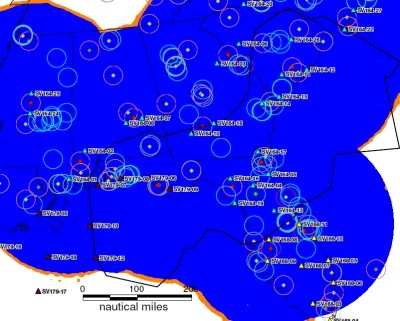Fri, Aug 27, 2010
Free Services For ADS-B Equipped Aircraft
Pilots who fly in or near Jacksonville, FL (ZJX) can now receive
free traffic and weather broadcast information in the cockpit. To
receive these services, aircraft must be equipped with an Automatic
Dependent Surveillance - Broadcast (ADS-B) transmitter/receiver or
transceiver and compatible cockpit display.

FAA Jacksonville TIS-B FIS-B Coverage Map
The new services include Flight Information Service - Broadcast
(FIS-B), which provides pilots and flight crews with a cockpit
display of aviation weather and aeronautical information via
Universal Access Transceiver (UAT) equipment on 978 MHz. The FAA
notes that FIS-B is not compatible with 1090ES avionics.
The FAA says that FIS-B weather products are for advisory use only.
The information provided by FIS-B can not be used in compliance of
any regulatory requirement. Pre-flight weather briefings and
in-flight weather updates must be obtained through FAA approved
sources only.
Among the FIS-B products being broadcast in ZJX region are:
- Aviation Routine Weather Reports (METARs).
- Special Aviation Reports (SPECIs).
- Terminal Area Forecasts (TAFs) and their amendments.
- NEXRAD (regional and CONUS) precipitation maps.
- Notice to Airmen (NOTAM) Distant and Flight Data Center.
- Airmen's Meteorological Conditions (AIRMET).
- Significant Meteorological Conditions (SIGMET) and Convective
SIGMET.
- Status of Special Use Airspace (SUA).
- Temporary Flight Restrictions (TFRs).
- Winds and Temperatures Aloft.
- Pilot Reports (PIREPS).
- TIS-B service status.

Traffic Information Service - Broadcast (TIS-B) is an
advisory-only service which enhances a pilot's visual acquisition
of other traffic displayed in the cockpit of properly-equipped
aircraft. Pilots must continue to exercise vigilance to "see
and avoid" other aircraft in accordance with Title 14 of the Code
of Federal Regulations Section 91.113b.
TIS-B and FIS-B are available to aircraft equipped with a 978
MHz Universal Access Transceiver (UAT). Aircraft equipped with a
1090 MHz Extended Squitter (1090 ES) will be able to receive only
the TIS-B information
The FAA encourages users of TIS-B and FIS-B to report any
irregularities observed while using the services. Reports should
contain the following information:
- Time of observation.
- Location.
- Type and identity of the aircraft.
- Description of the condition observed.
- Type of avionics system and software version used.
Pilots can report issues by contacting the nearest FSS facility
or by submitting FAA Form 8470-5, Safety Improvement Report,
available from FSSs, Flight Standards District Offices, or general
aviation fixed-based operators.
More News
Circle To Runway (Runway Number) Used by ATC to inform the pilot that he/she must circle to land because the runway in use is other than the runway aligned with the instrument appr>[...]
Aero Linx: National Aviation Safety Foundation (NASF) The National Aviation Safety Foundation is a support group whose objective is to enhance aviation safety through educational p>[...]
At Altitude Of About 250-300 Ft Agl, The Airplane Experienced A Total Loss Of Engine Power On November 6, 2024, at 1600 central standard time, a De Havilland DHC-1, N420TD, was inv>[...]
From 2009 (YouTube Edition): Three Hour Flight Was 'Flawless' -- At Least, Until Mother Nature Intervened For anyone who loves the aviation business, this was a VERY good day. Afte>[...]
Also: AMA Names Tyler Dobbs, More Falcon 9 Ops, Firefly Launch Unsuccessful, Autonomous F-16s The Air Force has begun ground testing a future uncrewed jet design in a milestone tow>[...]
 ANN's Daily Aero-Term (05.05.25): Circle To Runway (Runway Number)
ANN's Daily Aero-Term (05.05.25): Circle To Runway (Runway Number) ANN's Daily Aero-Linx (05.05.25)
ANN's Daily Aero-Linx (05.05.25) NTSB Prelim: De Havilland DHC-1
NTSB Prelim: De Havilland DHC-1 Classic Aero-TV: The Boeing Dreamliner -- Historic First Flight Coverage
Classic Aero-TV: The Boeing Dreamliner -- Historic First Flight Coverage Airborne-NextGen 05.06.25: AF Uncrewed Fighters, Drones v Planes, Joby Crew Test
Airborne-NextGen 05.06.25: AF Uncrewed Fighters, Drones v Planes, Joby Crew Test




